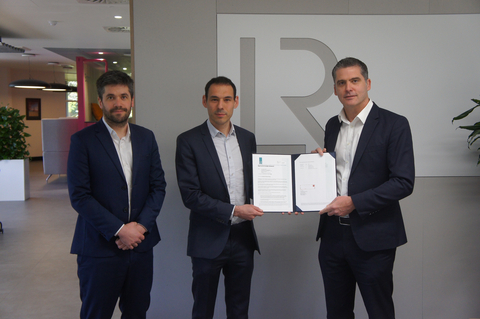
H2SITE’s AMMONIA to H2POWER Technology Receives Approval in Principle From Lloyd’s Register
Published by Todd Bush on April 29, 2024
H2SITE’s AMMONIA to H2POWER technology for ammonia cracking on-board has received Approval in Principle (AiP) from Lloyd’s Register (LR).
The technology is an onboard containerised solution that produces fuel-cell-quality hydrogen using ammonia. This hydrogen can then be utilised by hydrogen fuel cells that can contribute to the vessel’s electrical power, or the hydrogen could be consumed directly in an internal combustion engine (ICE).
April 29, 2024 02:30 AM Eastern Daylight Time
LOIU, Spain--Ammonia cracking is gaining momentum as a potential hydrogen carrier for onboard applications and this system is based on H2SITE’s hydrogen-selective membranes that overcome the thermodynamic limitations of the ammonia cracking reaction by recovering hydrogen continuously and resulting in virtually complete ammonia conversion and higher efficiencies at lower temperatures, reducing overall energy consumption and footprint.

>> In Other News: Zefiro Registers its First Methane Reduction Project on American Carbon Registry
In awarding the AIP, the design and arrangement evaluation included an overall examination of fundamental aspects of the design and compliance with LR’s Rules and Regulations for the Classification of Ships using Gases or other Low-flashpoint Fuels. A preliminary appraisal of rules was undertaken, followed by a risk assessment conducted to ensure that the risks arising from the use of ammonia and hydrogen are addressed according to LR’s ShipRight Procedure for Risk-Based Certification (RBC).
H2SITE operationally demonstrated its ammonia to hydrogen power technology last November when the Zumaia Offshore’s Bertha B vessel carried onboard AMMONIA to H2POWER technology, validating its performance in actual offshore conditions.
"We are proud to have achieved this milestone, as it validates the design and safety of our onboard ammonia cracking technology for decarbonizing maritime applications based on membrane reactors. Having commissioned our first cracker and fuel cell unit last year aboard the supply vessel Bertha B, we are currently scaling up the technology and designing MW-scale units." according to Jose Medrano Technical Director at H2SITE.
These AMMONIA to H2POWER systems will be integrated with both propulsion systems and auxiliary power units to serve a range of vessels, from offshore platforms to tankers and gas carriers.
Mark Darley, Chief Operations Officer, Lloyd’s Register added: “H2SITE's AMMONIA to H2POWER technology represents an exciting opportunity for shipowners to convert ammonia, and other feedstocks such as methanol, to hydrogen onboard their vessels without using additional gas separation technology”.
“We are pleased to award the AiP for this novel solution, and we remain dedicated to working with the maritime value chain to provide zero-emission power solutions that can contribute towards a greener, more sustainable future.”
About H2SITE
H2SITE was created in 2020 and has an exclusive technology of reactors and separators for the conversion of different feedstocks into hydrogen, among which are ammonia, methanol, or synthetic gas, in addition to the separation of hydrogen from gaseous mixtures in low concentration for applications in salt caverns or geologic hydrogen.
About Lloyd’s Register
Trusted maritime advisers, partnering with clients to drive performance across the ocean economy. Lloyd’s Register (LR) is a global professional services group specialising in marine engineering and technology. With a heritage going back more than 260 years to the establishment of the world’s first marine classification society, LR is dedicated to setting and improving standards for the safety of ships.
Today we are a leading provider of classification and compliance services to the marine and offshore industries, helping our clients design, construct and operate their assets to accepted levels of safety and environmental compliance. We also provide advice, support and solutions on fleet performance, fleet optimisation and voyage optimisation, enhancing our clients’ digital capabilities. Our digital solutions are relied upon by more than 20,000 vessels.
In the race to zero emissions, our research, technical expertise and industry-firsts are supporting a safe, sustainable maritime energy transition.
Lloyd’s Register Group is wholly owned by the Lloyd’s Register Foundation, a politically and financially independent global charity that promotes safety and education.
Find out more lr.org
Subscribe to the newsletter
Daily decarbonization data and news delivered to your inbox
Follow the money flow of climate, technology, and energy investments to uncover new opportunities and jobs.
Latest issues
-
The Three-Continent Move That Redefines SAF
Wishing everyone a restful holiday season.🎄🎅🎁 Inside this Issue ✈️ Cathay Goes Global With SAF in Three-Continent Fuel Deal 🧪 Proton Ventures Partners With Barents Blue For Realization Of The Bar...
-
Can One Truck Fix Hydrogen’s Biggest Problem?
Inside This Issue 🚛 Alberta's Shared Truck Model Could Crack Hydrogen Adoption ✈️ ZeroAvia Completes Financing Round 🌾 Frontier And NULIFE Scale New Biowaste Carbon Removal Approach 🔥 WAGABOX® Of ...
-
North America’s Carbon Removal Year in Review: Winners, Losers, Surprises
Inside This Issue 🌎 North America's Carbon Removal Year in Review: The Deals, Policies, and Milestones That Shaped 2025 🚢 Hapag-Lloyd And North Sea Container Line Win ZEMBA Second E-Fuel Tender 🪨 ...
Company Announcements
-
ClimeFi Announces New 85,000 Tonne Procurement Round
In its latest procurement round, ClimeFi has enabled more than US$18m in durable carbon removal purchases across eight removal pathways: Biochar, Bioenergy with Carbon Capture and Storage (BECCS), ...
-
Vallourec, a world leader in premium seamless tubular solutions, and Geostock, a global specialist in underground storage of energy, have signed a Memorandum of Understanding (MoU) to strengthen th...
-
CMA CGM, DHL Step Up Ocean Freight Decarbonization with Biofuel Deal
DHL Global Forwarding and shipping group CMA CGM have agreed to jointly use 8,990 metric tons of second-generation biofuel to reduce emissions from ocean freight. The initiative is expected to cut...
-
Next-Generation Gas Turbine Control System For Thermal Power Plants Completes Functional Testing
Integration of Mitsubishi Power's control technology with Mitsubishi Electric's high-speed data processing technology Supports rapid load adjustments and diverse fuels including hydrogen Tokyo, ...